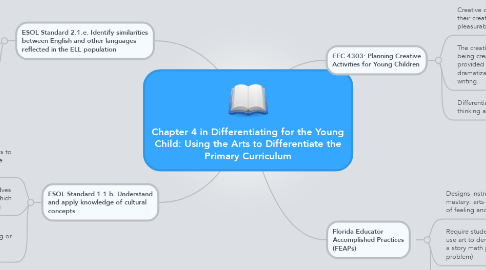Chapter 4 in Differentiating for the Young Child: Using the Arts to Differentiate the Primary Curriculum
by Kaeleigh Carson

1. EEC 4303: Planning Creative Activities for Young Children
1.1. Creative curriculum allows students to explore their creativity and make learning more pleasurable.
1.2. The creative process: children learn and discover through the process of being creative (examples of activities that focus on the process are provided in Chapter 4 of Differentiating). Activities may include dramatizations of math problems rather than solving them strictly in writing.
1.3. Differentiating using the arts encourage creative thinking and helps children develop cognitively.
2. ESOL Standard 1.1.b. Understand and apply knowledge of cultural concepts
2.1. Integrating art into curriculum allows students to explore different cultural arts as well as share their culture to their peers and teacher
2.2. Allowing students to express themselves creatively creates a cultural identity which affects views and interests in learning
2.3. Arts-integrated curriculum allows students at different English proficiency levels to participate in different activities (i.e. drawing or role-play provides visuals to aid lower proficiency students with subject learning)
3. ESOL Standard 2.1.e. Identify similarities between English and other languages reflected in the ELL population
3.1. Lessons can be shared in different languages using creative curriculum. For example, music can be shared in English and Spanish then students and teacher can compare and contrast.
3.2. Language arts and theater can be used to explore other languages in the classroom.
4. Florida Educator Accomplished Practices (FEAPs)
4.1. Designs instruction for students to achieve mastery: arts-infused curriculum create a depth of feeling and inspire creative thinking
4.2. Require students to demonstrate variety of skills: students use art to demonstrate knowledge in creative ways (i.e. telling a story math problem rather than only solving a textbook problem)
4.3. Respects cultural background: arts allow students to share and express cultural creativity


